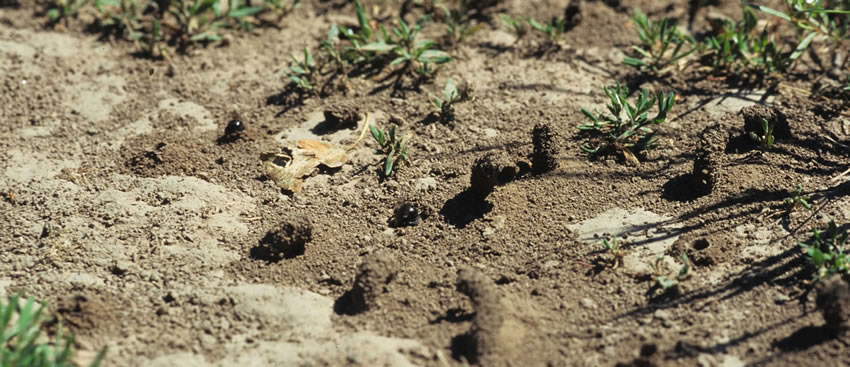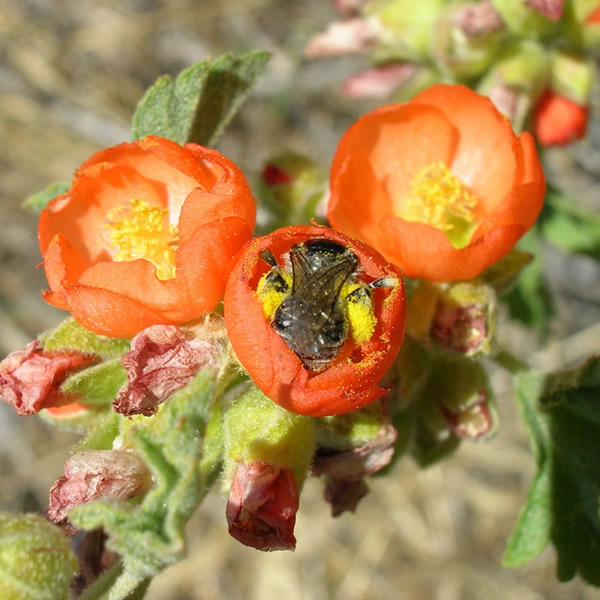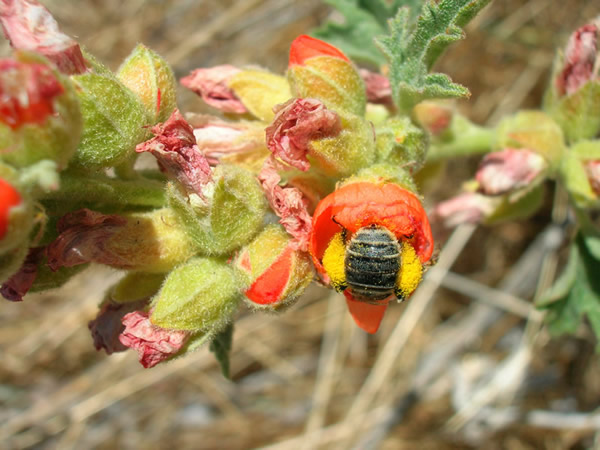Globe Mallow Bee (Diadasia diminuta)
By Vince Tepidino USDA ARS (retired), Bee Biology & Systematics Lab, Logan, Utah
Relatively few animals run their “economy” exclusively on the energy contained in floral nectar and the nutrients found in pollen. Foremost among these are bees, those vegetarians extraordinaire, of which there are some 16,000 known kinds. In contrast to the well-known but unique honeybee, which is both highly social and wide-ranging in its flower visits, most bee species are solitary (no hives, no workers, each female the matriarch of her own patriarch less abode). Many are rather “picky” in the flowers they visit: they only collect pollen from a very small number of the available kinds of flowers, i.e., they specialize.
An example of a specialized bee is the globe mallow bee, Diadasia diminuta. The globe mallow bee is about 7 to 9 mm long, and collects pollen from its favorite food plant, globe mallow (Sphaeralcea). Female globe mallow bees are equipped with long, highly plumose hairs on their hind legs which receive and carry the large pollen grains (visible as yellow masses) back to the nest. There, the pollen grains are combined with nectar and molded into a loaf which serves as food for offspring. Each offspring has its own “loaf” in its own “room” (cell) in the nest, which is excavated in the ground, all courtesy of “mom” acting independently. Nests are commonly found in partially compacted soil along the margins of dirt roads in the western United States. Frequently, Diadasia bees surround the nest entrance with a turret (chimney), the purpose of which has long been debated. Do turrets 1) help keep rain or soil out of the nest, 2) help females recognize their nest when they return from foraging, or 3) discourage enemies? Investigation of this mystery continues.
 Why the globe mallow bee (Diadasia diminuta) builds turrets (chimneys) surrounding the entrance to their nest is still debated by the scientific community. Photo by Vince Tepedino, ARS Bee Research Lab.
Why the globe mallow bee (Diadasia diminuta) builds turrets (chimneys) surrounding the entrance to their nest is still debated by the scientific community. Photo by Vince Tepedino, ARS Bee Research Lab.
Globe mallow bees not only draw their sustenance from the flowers, they are also important pollinators. As is evident from the picture, the bees become covered with pollen visiting the flowers. Most of this pollen is groomed into the pollen basket on the hind legs and taken back to the nest. However, some remains on the body and is deposited on the stigma of each of the next few globe mallow flowers visited. Thus, Diadasia contributes to globe mallow reproduction.
Although all known species of the Diadasia group have specialized flower-foraging habits, not all specialize on globe mallow flowers. Other Diadasia species confine their flower-visits to other plant groups such as cacti, sunflowers, wild bindweeds, and other kinds of mallows. How this pattern of specialized host choice for such distantly related plants has arisen in this group of bees is of great, and continuing, interest to evolutionary biologists.



